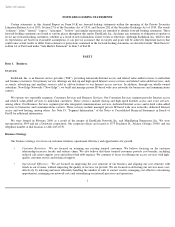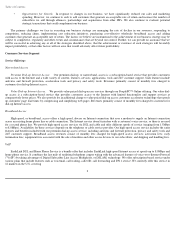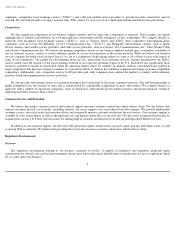Earthlink 2008 Annual Report Download - page 13
Download and view the complete annual report
Please find page 13 of the 2008 Earthlink annual report below. You can navigate through the pages in the report by either clicking on the pages listed below, or by using the keyword search tool below to find specific information within the annual report.
Table of Contents
of content by minors, anti-
spyware initiatives, encryption, data protection, data retention and security breaches. Compliance with these laws and
regulations is complex and may require significant costs. In addition, the regulatory framework relating to Internet services is evolving and both
the federal government and states from time to time pass legislation that impacts our business. It is likely that additional laws and regulations
will be adopted that would affect our business.
Telecommunications Regulation
We offer voice services to our customers through VoIP products. VoIP regulation is generally preempted at the state level and federal law
does not require a telecommunications license to provide these services. However, the FCC has placed several regulatory requirements on VoIP
services that interconnect with the public switched telephone network (PSTN). Along with these existing and future FCC regulatory
requirements, there is also the possibility that states will continue to attempt to assert authority over VoIP services, which presents a business
risk for our VoIP services.
Regulatory Classification
In 2004, the FCC initiated a proceeding to determine whether VoIP should be considered an "information service" or a
"telecommunications service." This determination remains pending. The classification of VoIP as a telecommunications service would have
significant ramifications for all VoIP providers, including us. Classifying VoIP as a telecommunications service would require the service
provider to obtain a telecommunications license, comply with numerous legacy telephone regulations, and possibly subject the VoIP traffic to
inter-carrier access charges, which could result in increased costs.
Jurisdiction
One regulatory issue that continues to evolve is whether state regulatory agencies have jurisdiction of VoIP services, including our
nomadic-
style VoIP service and our fixed line VoIP service. If courts determine that states have jurisdiction, several states are expected to levy
state universal service fees and other regulatory fees on the intrastate portion of VoIP revenue. This would increase the cost of our services and
adversely affect our VoIP business. In addition, if courts determine that states can regulate fixed line VoIP as a telephone service and, among
other requirements, subject these services to the carrier access charge regime, our costs of providing this service would increase and our VoIP
business would be adversely affected.
Regulatory Obligations
The FCC has imposed seven distinct regulatory obligations on VoIP services that interconnect with the PSTN: (i) access to emergency
calling; (ii) compliance with Communications Assistance with Law Enforcement Act (or CALEA); (iii) payments to the federal universal service
fund on interstate revenue; (iv) compliance with rules for disability access; (v) payments for regulatory fees; (vi) compliance with customer
proprietary network information ("CPNI") procedures; and (vii) compliance with number portability rules.
These obligations are primarily focused on social and law enforcement policies, rather than economic regulation of the service. In each
case, our service is, or we expect it will be, in compliance with these regulatory obligations, and none of these obligations materially affect our
ability to provide VoIP services.
CLEC Regulation
New Edge is a competitive local exchange carrier (or CLEC) that is licensed in most states and subject to both state and federal
telecommunications regulation. CLECs, like New Edge, are dependent on certain provisions of the 1996 Telecommunications Act to procure
facilities and services from ILECs that are necessary to provide their services. The business of New Edge is highly dependent on rules and
rulings
9
























